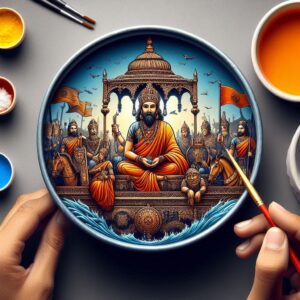Historians have different opinions regarding the caste of the Gupta rulers. Vajjika has written Guptas as Jart i.e. Jat in Kirtikaumudi Natak. On this basis, Kashiprasad Jayaswal has considered Guptas as Shudras. Romila Thapar considered them as prostitutes, D.R. Bhandarkar considered them as Kshatriyas and Hemchandra Roy Chaudhary considered them as Brahmins.
Gupta belonged to the Brahmin caste. Chandragupta-2’s daughter Prabhavati Gupta was married to Rudrasen-2, the ruler of the Vakataka dynasty. Pune copper plate of Prabhavati Gupta has been found in which she has described herself as a Brahmin of Dharani gotra. This gotra was of her father because her husband’s gotra was Vishnuvriddhi.

Gholch of the Gupta dynasty was established in 275 AD by Shrigupta and became the ruler and after this Gatotkach became the ruler. Both of them had assumed the title of Maharaj. In the Pune copper plate and Supiya inscription of Samudragupta (Madhya Pradesh), the beginning of the Gupta dynasty has been mentioned from Gatotkach.
Chandragupta – I [319 AD to 335 AD]
On the occasion of becoming the ruler, he started the Gupta Samvat, which is also confirmed by Al Biruni’s book Kitabulhind, in which it is written that there was a difference of 24 years between the Gupta Samvat and the Shaka Samvat.
Chandragupta I assumed the title of Maharajadhiraja. Chandragupta I was married to Kumar Devi, princess of the Lichchhavis of the Vaishali republic and on this occasion, gold coins of the Raja-Rani type were issued. This marriage was so important that Samudragupta called himself the Lichchhavi grandson in his coins.
Samudragupta [335 A.D. to 375 A.D.]
The main source of information about Samudragupta is Prayag Prashasti which is written on Ashoka’s Prayag-Kaushambi pillar. This prashasti was composed by Samudragupta’s treaty maker Harisen and Tilbhatta engraved it on stone. This prashasti is written in Sanskrit language, Brahmi script, and Champu style (prose-poetry). This prashasti has 32 lines and the credit for bringing it to light goes to Andrew Dryer. This prashasti mentions the victories of Samudragupta on the basis of which VA Smith has called Samudragupta the Napoleon of India.
- Samudragupta defeated 4 states in the first war of Aryavarta, this is mentioned in the 13th and 14th lines of Prayag Prashasti.
- After this, Samudragupta went to South India and defeated a union of 12 kings in the battle of Dakshinapath. This union was led by Vishnugopa, the ruler of the Pallava dynasty of Kanchi (Tamil Nadu). This is mentioned in the 19th and 20th lines.
- The policy adopted by Samudragupta towards the rulers of South India is called ‘Grahan-Salvation-Anugraha’.
- Hemchandra Choudhary has called it the religious victory of Samudragupta.
- When Samudragupta was in South India, the rulers of North India tried to become independent, so he returned to North India and defeated 9 kings in the second war of Aryavarta and adopted the policy of Prasabhodvarana (total destruction) towards them. This is mentioned in the 21st line.
- When the sea was going to South India, the tribal (wild) tribes created obstacles. After defeating them, the policy of serving them was adopted. This is mentioned in the 21st line.
- Samudragupta adopted the policy of pranamagaman, agyakaran and sarvakardanam towards the direct (bordering) states. This is mentioned in line 22.
- The contemporary foreign powers of Samudragupta were Shakas and Kushanas. He adopted the policy of surrender, Kanyopayana, and Garutmandaka towards them. This is mentioned in the 23rd and 24th lines.
These subjects of Samudragupta have been called Dharanibandh (world conquest). The Ashwamedha Yagna performed by Samudragupta is not mentioned in this prashasti.
Samudragupta’s mother Kumar Devi is mentioned in this same eulogy.

Eran (Madhya Pradesh) is said to be the Bhoga Nagar (place of rest after war) of Samudragupta. An inscription of Samudragupta has been found from Eran in which he has been compared to Yama and Kubera.
Vasubandhu and Ananguddha were the court writers of Samudragupta who wrote Abhidhammakosha and Yogachara respectively.
Samudragupta issued 6 types of gold coins –
- Garuda
- tiger
- Archer: On these coins, Samudragupta is shown riding a chariot and has been given the title of Apratiratha i.e. unique warrior.
- Parashu – On these coins Samudragupta is shown to be similar to Parashurama Ashwamedha Yagna
- Veena – On these coins, Samudragupta is shown playing Veena and he has been given the title of Kaviraja.